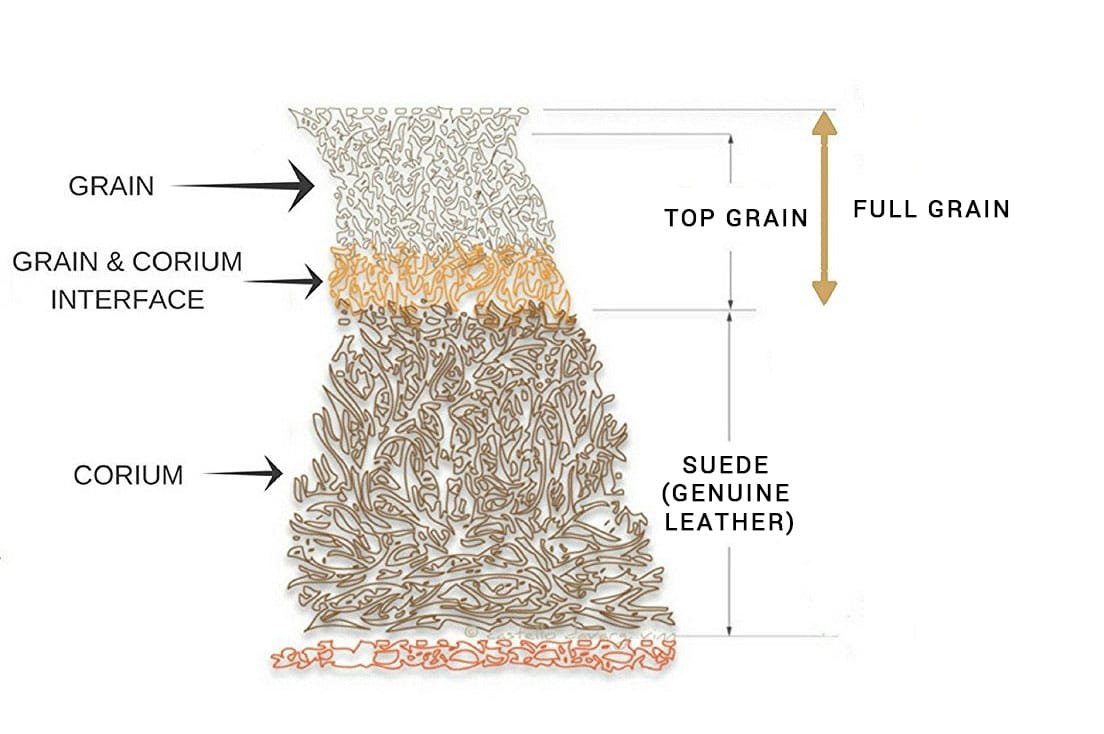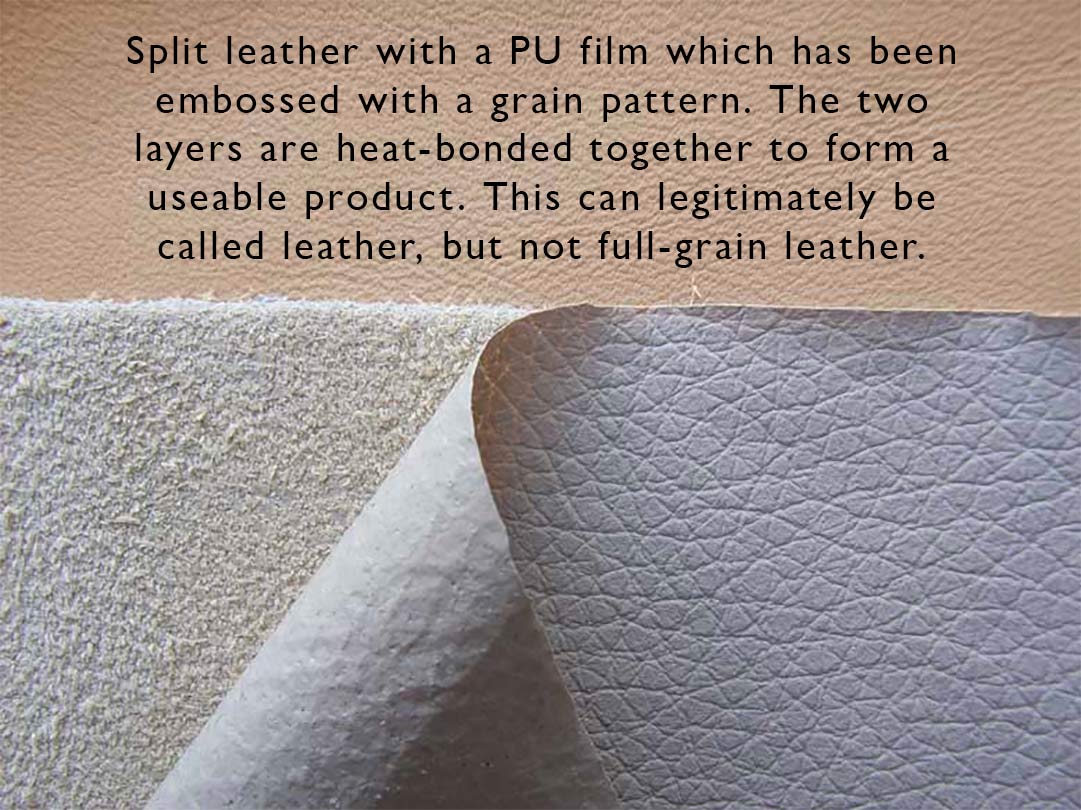Full-grain leather is the highest quality, using the entire outer layer of the hide for unmatched durability. Split leather is the lower layer and is weaker.

Table of Contents
- What Is the Difference? Understanding the Layers of a Hide
- What Exactly is Full-Grain Leather? The Mark of True Quality
- What is Split Leather? A Closer Look at the Lower Layers
- Full-Grain vs. Split Leather: A Head-to-Head Comparison
- The “Genuine Leather” Misconception: What Are You Really Buying?
- How Can You Identify Quality Leather?
- Why Does the Type of Leather Matter for Your Goods?

What Is the Difference? Understanding the Layers of a Hide
When you look at a piece of leather, you are seeing a material crafted from animal hide. But not all parts of the hide are created equal. The fundamental difference between full-grain and split leather comes from which layer of the animal hide is used. Imagine a thick hide being separated into two or more horizontal layers by a splitting machine. The outermost layer is the most prized, while the inner layers have vastly different properties.

The top layer, exposed to the elements, contains the tightest and most durable fiber structure. This is the source of full-grain leather. It includes the complete grain of the hide, with all its natural imperfections, scars, and markings, which tell the story of the animal’s life. The layers beneath this top cut are known as split leather. These inner layers have a looser, less dense fiber structure, making them inherently weaker and less resilient than their full-grain counterpart.
What Exactly is Full-Grain Leather? The Mark of True Quality
Full-grain leather stands at the apex of quality and is the most sought-after material for premium goods. It is derived from the very top layer of the hide and undergoes minimal processing. The surface is left untouched, preserving the natural grain—the pores, wrinkles, and even minor scars. This authenticity is a testament to its quality, as only the cleanest and most pristine hides can be used for full-grain products.
Because the dense fiber network of the epidermis is kept intact, full-grain is the strongest and most durable type of leather available. It resists moisture and wear far better than any other grade. This is why companies committed to heirloom-quality products, like Beldura Leather, exclusively use full-grain materials for their bags and accessories. An investment in a full-grain product is an investment in a piece that will last for generations.
Appearance and Natural Markings
The most defining characteristic of full-grain leather is its authentic, unblemished surface. It proudly displays the natural texture of the hide. You might see small healed scratches, insect bites, or fat wrinkles. These are not defects; they are hallmarks of genuine, high-quality leather. This unique character ensures that no two full-grain products are exactly alike. The surface feels rich and has a natural, slightly oily touch, indicative of its high quality and minimal artificial treatment.
Unmatched Durability and Strength
The strength of full-grain leather lies in its tightly interwoven fibers, which are densest at the very top of the hide. By not sanding or buffing this layer, its structural integrity remains completely intact. This makes it incredibly resistant to tearing, puncturing, and stretching. Over time, while lesser leathers may crack or peel, full-grain leather will simply mold to its use, becoming more comfortable and personal without sacrificing its strength.
The Beauty of Patina: How Full-Grain Ages
Perhaps the most magical quality of full-grain leather is its ability to develop a patina. A patina is a soft, rich sheen that develops on the surface through use and exposure to the environment. The oils from your hands, sunlight, and daily friction all contribute to a darkening and polishing of the leather, creating a unique finish that is deeply personal to the owner. This aging process enhances its beauty, adding character and depth that cannot be replicated artificially. Split leather, in contrast, does not develop a patina; it simply wears out.
What is Split Leather? A Closer Look at the Lower Layers
Split leather is created from the fibrous part of the hide left over once the top-grain layer has been separated. This lower layer, sometimes called the “drop split,” has a much looser and less durable fiber structure. Because it lacks a natural grain surface, it often requires significant processing to be made usable for consumer products. This usually involves applying an artificial finish, such as a polymer coating or a heavy embossing, to mimic the appearance of a higher-grade leather.
While split leather is still technically real leather, its quality is significantly inferior. Its primary advantage is cost. Because a single thick hide can yield several splits, it is a much more economical material. This makes it a common choice for budget-friendly furniture, shoe linings, and the backing of belts where durability is not the primary concern.
Processing and Common Uses
To create a usable surface, split leather is often treated in several ways. One common form is suede, which is made by sanding the inner split to create a soft, napped finish. For other applications, a completely artificial polyurethane (PU) or vinyl layer is applied and embossed with a grain-like pattern. This is often marketed as “coated split” or “bicast leather.” While it may look like premium leather initially, this artificial surface is prone to cracking and peeling over time.
Durability Concerns and Limitations
The primary drawback of split leather is its lack of strength and longevity. The loose fiber structure makes it susceptible to stretching and tearing. It does not handle moisture or abrasion well, and the artificial coating applied to its surface can easily scuff, crack, or delaminate. Unlike full-grain leather that improves with age, split leather degrades, losing its initial appearance and structural integrity with use.
Full-Grain vs. Split Leather: A Head-to-Head Comparison
Understanding the key differences helps in making an informed decision. This table breaks down the essential characteristics of each leather type.
| Feature | Full-Grain Leather | Split Leather |
|---|---|---|
| Source Layer | Outermost layer of the hide | Inner, lower layers of the hide |
| Durability | Highest; extremely strong and resilient | Low; prone to stretching and tearing |
| Surface | Natural grain with unique markings | Often artificially coated and embossed |
| Aging Process | Develops a beautiful patina over time | Wears out; surface can crack or peel |
| Breathability | Excellent, due to natural pores | Poor, especially when coated |
| Cost | High (premium investment) | Low (budget-friendly) |
The “Genuine Leather” Misconception: What Are You Really Buying?
One of the most misleading terms in the industry is “Genuine Leather.” Many consumers believe this label signifies high quality. In reality, it is often a catch-all term for leathers that are not full-grain or top-grain. More often than not, products stamped with “Genuine Leather” are made from split leather that has been heavily processed and painted to look uniform.
While technically made from animal hide, “Genuine Leather” sits near the bottom of the quality hierarchy. It lacks the strength, durability, and aging potential of full-grain leather. It is a marketing term designed to sound appealing but often conceals a lower-grade material. When seeking a product that will last, it is critical to look past this vague label and seek out specifics like “full-grain.”
How Can You Identify Quality Leather?
Distinguishing full-grain from split leather can be simple if you know what to look for. First, examine the surface closely. Full-grain leather will have small, natural imperfections—tiny pores, wrinkles, and subtle variations in color. A heavily processed split leather will look perfectly uniform, almost like plastic, because its surface is artificial.
Press your fingernail into the leather. Full-grain will show a temporary mark that fades, indicating its natural, oily composition. A coated split leather will feel rigid and show little to no change. Finally, consider the smell. Full-grain leather has a rich, earthy aroma, while many split leathers have a chemical or plastic-like smell from their coatings. The edges can also be revealing; full-grain items often have raw, burnished edges that showcase the dense fibers, whereas splits may be painted or folded over to hide the less appealing cross-section.
Why Does the Type of Leather Matter for Your Goods?
The choice between full-grain and split leather directly impacts the lifespan, appearance, and overall value of your product. For items that endure daily use—such as a wallet, a briefcase, or a travel bag—durability is paramount. Split leather may look acceptable on the shelf, but it will quickly show signs of wear, with coatings peeling and seams stretching.
In contrast, a full-grain leather product is a long-term companion. At Beldura Leather, our dedication to using only the finest full-grain leather in our collection ensures that every piece is not just an accessory, but a durable work of art designed to withstand the test of time. It absorbs the experiences of its user, developing a character that is entirely its own. Choosing full-grain is choosing quality that endures, style that matures, and an item that truly gets better with every passing year.
Article Outline
H1: Split Leather vs Full Grain: The Hidden Truth About Leather Quality
Core Keywords: Full Grain Leather, Split Leather, Leather Quality
Long-tail Keywords: what is the difference between split and full grain leather, is split leather real leather, how does full grain leather age, why is full grain leather expensive, identifying full grain vs split leather
-
H2: What Is the Difference? Understanding the Layers of a Hide
- Discussion of the cross-section of an animal hide and where each type of leather originates.
-
H2: What Exactly is Full-Grain Leather? The Mark of True Quality
- H3: Appearance and Natural Markings
- H3: Unmatched Durability and Strength
- H3: The Beauty of Patina: How Full-Grain Ages
-
H2: What is Split Leather? A Closer Look at the Lower Layers
- H3: Processing and Common Uses (Suede, Coated Splits)
- H3: Durability Concerns and Limitations
-
H2: Full-Grain vs. Split Leather: A Head-to-Head Comparison
- A comprehensive table comparing key features like source, durability, aging, and cost.
-
H2: The “Genuine Leather” Misconception: What Are You Really Buying?
- Exposing the marketing term and clarifying its position in the quality hierarchy.
-
H2: How Can You Identify Quality Leather?
- Practical tips for consumers to inspect and identify leather types (look, feel, smell).
-
H2: Why Does the Type of Leather Matter for Your Goods?
- Connecting leather quality to product longevity and value, with a subtle mention of Beldura’s commitment to quality.
Anchor Text Suggestions
- The difference between split and full grain leather
- Understanding leather quality
- Why we choose full-grain leather
- How to identify premium leather
- What does “Genuine Leather” really mean?
- The truth about leather grades
- Investing in a full-grain leather bag
- How high-quality leather ages

